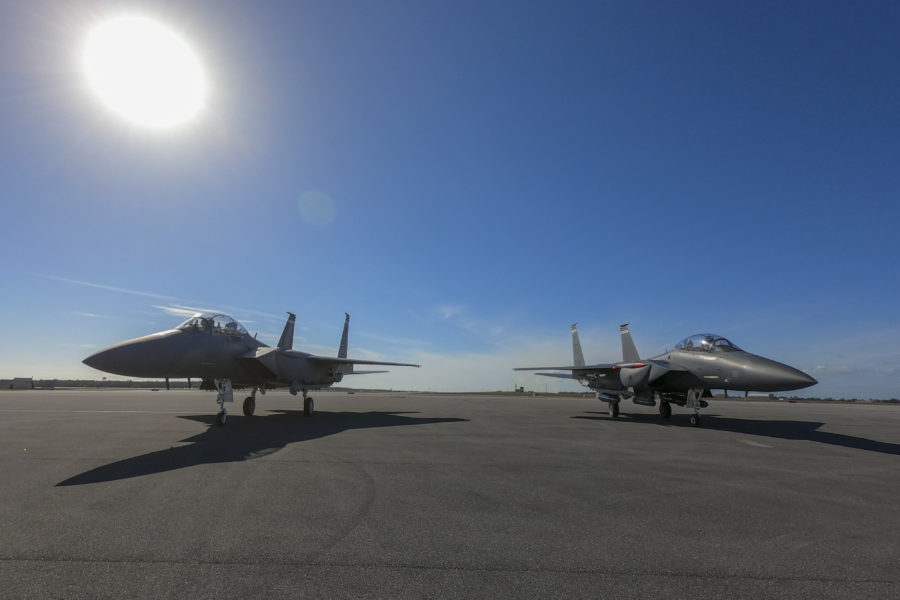The Air Force upped its buy of F-15EX Eagle IIs in part to fulfill the homeland defense mission and ensure the Air Force reached a goal of 72 new fighters a year, top Air Force leaders said March 15. But the service does not plan to buy any more of the Boeing-made jets in the future, leaving it with a final fleet of 104 F-15EXs.
“There’s no intention to do that right now,” Kendall said when asked if the Air Force planned further F-15EX purchases at the annual McAleese and Associates defense conference.
The service originally planned to stop buying the refreshed version venerable fourth-generation fighter by now. But Congress budgeted for 24 F-15EXs in fiscal 2023 and Air Force matched that number in its request for fiscal 2024. The Air Force wants to purchase 48 F-35s in fiscal 2024 along with the 24 F-15EXs, which makes up the 72 fighter figure.
“It’s not just the 72 a year, it’s the mixture of capability and capacity that goes with that fighter capability,” Air Force Chief of Staff Gen. Charles Q. Brown Jr. said.
The Air Force has not detailed exactly where the new airframes will go, but Kendall indicated some of the F-15EXs would replace aging F-15C/D Eagles in the Air National Guard fleet.
“The reason we do that in part because of the cruise missile defense mission,” Kendall said of the F-15EX and F-35 buys.
The Air Force’s plan F-15EX buy would not fully replace F-15C/Ds in the fleet, however, and some Air National Guard F-15C/Ds are being replaced with F-35s. The Air Force has around 200 F-15C/Ds that it will eventually retire, and the service wants to divest 57 in fiscal 2024. The Air Force made the decision to pull its 48 F-15C/Ds from Kadena Air Base, Japan in late 2022, with some of those aircraft destined for the Air National Guard.
“We’re going to continue to draw that fleet down until there’s none left,” the director of the Air National Guard Lt. Gen. Michael A. Loh told reporters March 8 at AFA’s Warfare Symposium. “So the recapitalization is occurring. … The two things on the production line right now are F-35 and F-15EX.”
But the Air Force says it will not be increasing its long-term commitment to F-15EX at the expense of stealthy F-35s, which it sees as the future backbone of the fighter fleet.
The additional batch of F-15EX will give the Air Force 104 F-15EXs, up from the 80 F-15EX fleet it detailed in last year’s budget request. The Air Force originally planned to buy 144 F-15EXs and has now changed that position several times. But a final inventory of 104 jets will remain the Air Force’s position—at least for now.
“23 came out a lot bigger than they had asked for, and so 24 is an increase on that,” Kendall said. “So basically, we have the capability to buy more, and so we did—same thing with F-35.”
The Department of Defense has been waiting on committing to buy more F-35s until the updated Block 4 and Technology Refresh 3 capabilities come online.
“We’d like to start climbing up the ramp a bit when we are pretty confident we’re going to get Block 4 aircraft,” DOD comptroller Michael A. McCord told reporters.
“This was probably the least debate about JSFs that I’ve seen inside the building process in the times I’ve done this,” said McCord, referring to the Joint Strike Fighter, the original name for the F-35 program. McCord previously served as the comptroller from 2014 to 2017, when the F-35 was first introduced into the Air Force fleet.
McCord said the services had more conversations inside the DOD to make sure F-35s didn’t show up on unfunded priorities lists. The Department of the Navy wants a mix of 35 F-35B and F-35C variants in its fiscal 2024 budget for the Marines and Navy, giving the Pentagon a wish list of 83 Lockheed Martin-made F-35s.
“We’ve kind of had a little bit better clarity in our internal process early on,” McCord said. “This is the comfort spot for the Department of Navy and the Department of Air Force and we didn’t really move off of that a lot or have a big discussion about it.”
